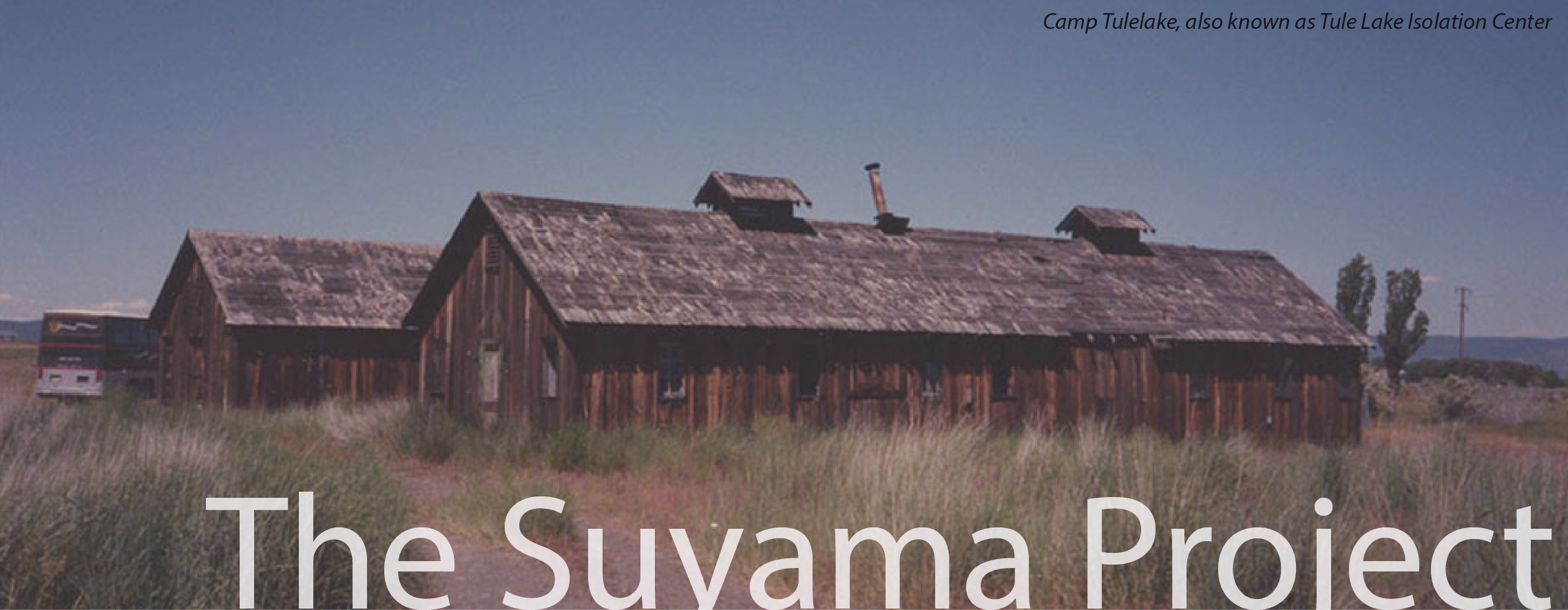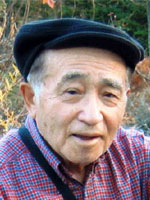
|
UCLA Asian American Studies Center's Suyama Project aims to preserve the history of Japanese American resistance during World War II, including, but not limited to the 100th/442nd Regimental Combat Team draftees, Army and draft resisters, No-Nos, renunciants, and other Nikkei dissidents of World War II. The Suyama Project is made possible through the generous gift of an anonymous donor who wanted to honor and remember the legacy of resistance, broadly understood. |
Editorials  Eji Suyama was a prolific contributor to the various Japanese American newspapers and probably has been published in all the Nikkei newspapers at some point.
Suyama's editorials were brash and opinionated but always fair and fearless.
Below are some of the major topics that Suyama wrote upon. However, some of the limitations we encountered while compiling Suyama's editorials was that whenever he wrote in response to someone else's opinion, it was difficult to locate the earlier opinion piece because many of the Japanese American newspapers that Suyama wrote for no longer exist and have not been archived at a public institution.
Additionally, when we did not have Suyama's published editorials, we have included his original typed letter, which he sent to various Nikkei newspapers.
We have presented Suyama's editorials in a way that should be easy to understand to viewers, and unless otherwise noted, all editorials are Suyama's. On the 442nd Regimental Combat Team Eji Suyama was drafted into the United States Army and served in the segregated 442nd Regimental Combat Team, the most decorated unit for its size and length of service in U.S. military history. He was one of the few soldiers to survive the bloody "Rescue of the Texas Lost Battalion."
The battle to rescue the "Lost Battalion" occurred in October 1944 in eastern France, where 275 soldiers of the 141st Infantry Regiment from Texas were surrounded by German troops. Earlier, two battalions from the same 141st Regiment had unsuccessfully attempted to rescue the men.
The 442nd had just liberated Bruyeres, Belmont and Biffontaine, but after merely two days of rest, they were ordered to rescue the trapped soldiers. Following four days of fierce battle, the 442nd reached the "Lost Battalion" and rescued 211 soldiers while suffering more than 800 casualties.
[Letter to the Editor, April 5, 1995]
["Oblique Critique," KaMai Forum, Sept. 13, 1995]
["Reflections of a Nisei Veteran," Nichi Bei Times, Dec. 12, 1995]
[Untitled, North American Post, Dec 23, 1998]
["Screwed Again, Part 1," North American Post, May 20, 2009]
On the Draft Resisters and Other U.S. Camp Protestors Because Eji Suyama was one of the few 442nd soldiers to survive the bloody battle to rescue the "Texas Lost Battalion," his support of the Japanese American World War II draft resisters and other protesters carried that much more weight.
For decades, he was the lone mainland 442nd veteran supporting the draft resisters and other protesters publicly. To do so took considerable courage since Suyama opened himself up to criticism.
Because the loyalty of Japanese Americans came under intense scrutiny during World War II, the Japanese American community became severely divided over what constituted loyalty towards ones country.
Government propaganda, backed by the Japanese American Citizens League (JACL), defined "loyalty" as serving in the military under any condition.
On the other hand, the government labeled those who resisted being drafted out of U.S. concentration camps or any form of Japanese American protest as "disloyal."
This misconception of alleged "disloyalty" has divided the Japanese American community to this day, and the issue has been debated publicly in various Japanese American newspapers.
The National JACL, after more than a decade of intense internal debate, passed a resolution at their 2000 national convention to issue a public apology to the draft resisters. During World War II, the wartime JACL leaders had actively opposed the draft resisters.
[Rafu — Horse's column, Sept. 8, 1992]
["Warriors for Change," Rafu Shimpo, Jan. 5, 1993]
[Letter to the Editor, March 9, 1993]
["Fair is Fair," by Mack Yamaguchi, KaMai Forum, March 26, 1997]
[Tozai Times/PC Oct 17-Nov 6, 1998 — Fred Hirasuna]
["Draft Resisters," by Gerald Horiuchi, Pacific Citizen, June 25-July 1, 1999]
[Letter to Editor, Aug 5, 1999]
["Nisei Veterans Vis-à-vis Draft Resisters" by Various Nisei Veterans]
[Letters to the Editor, Pacific Citizen, Feb. 16-March 1, 2001]
[PC July 20-Aug 2, 2001]
["A Lousy Deal," Pacific Citizen, April 4-17, 2003]
On Lt. Ehren Watada Eji Suyama never shied away from controversy, particularly if it dealt with a Japanese American in the military.
On March 19, 2003, the United States, under the presidency of George W. Bush, launched an invasion into Iraq. The Bush Administration, along with coalition forces consisting mainly of the United Kingdom, believed that Iraq, under the dictatorship of Saddam Hussein, possessed weapons of mass destruction (WMD).
Three weeks later, on May 1, 2003, President Bush appeared before a banner that declared "Mission Accomplished."
However, no weapons of mass destruction were ever found in Iraq, and despite President Bush's declaration, intense guerrilla warfare continued on for years in Iraq, costing thousands of military and civilian lives.
In June 2006, First Lt. Ehren Watada was to be deployed to Iraq as part of Operation Iraqi Freedom, but Watada refused to ship overseas, saying that he believed the war in Iraq to be illegal. He requested a transfer to serve in Afghanistan, since he believed there was clear evidence linking Afghanistan to the Sept. 11, 2001 attack on the Twin Towers in New York and the Pentagon but his request was denied.
His 2007 court-martial ended in a mistrial, and he was discharged in 2009.
Since Watada was an American of Japanese descent, his high profile court martial, created intense debate within the Japanese American community. Suyama was one of the few 442nd to unequivocally support Watada publicly.
["The JACL's Dilemma: To Be or Not To Be," Nichi Bei Times, Sept 14-20, 2006]
["An Historic Obligation," Pacific Citizen, Feb 16-March 1, 2007]
[Open Letter to Gen. Dubik, March 29, 2007]
["Is the Iraq War Legal?" by Milo Yoshino, Pacific Citizen, Nov 16-Dec 13, 2007]
["442nd Vet Supports Watada," Nichi Bei Times, Feb 2008]
["442nd Vet Continues to Support Watada," Pacific Citizen, March 7-20, 2008] On the Lim Report, the JACL (Japanese American Citizens League) and the NJAMF (National Japanese American Memorial Foundation) Controversy During the late 1990s and early 2000s, a national grassroots movement took form to oppose various inscriptions that were slated to be inscribed on a national monument in Washington DC to Japanese American patriotism during World War II.
At the center of the inscription controversy was the inclusion of a quote from Mike Masaoka, the controversial wartime leader of the Japanese American Citizens League (JACL). Although Masaoka had never been incarcerated in a U.S. style concentration camp during the war, he claimed to speak for the thousands of imprisoned Japanese Americans from the West Coast.
He advocated action such as using Issei as hostages while the Nisei served in suicide battalions to having Japanese Americans branded. These and other Masaoka recommendations have been documented in the Deborah Lim Report.
[On the Lim Report, Tozai Times, June 1994]
["Nikkei Cleansing: A Strained Comparison," KaMai Forum, June 19, 1999]
["Open Letter from Congressman Matsui in Support of Inscription," Nichi Bei Times, Dec. 24, 1999]
["Had There Been a Zandankai on Masaoka's Inscription," by Harry Honda, Pacific Citizen, June 2-8, 2000] |